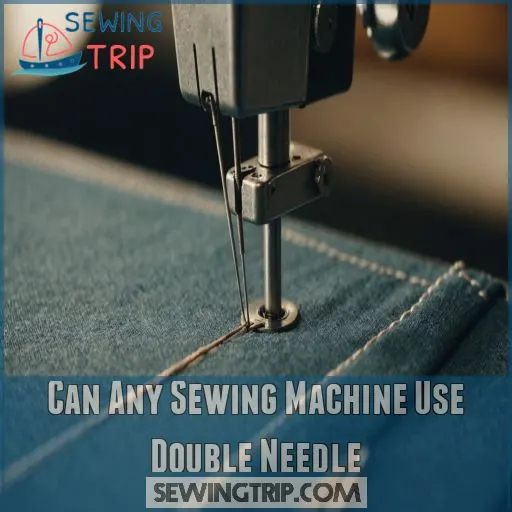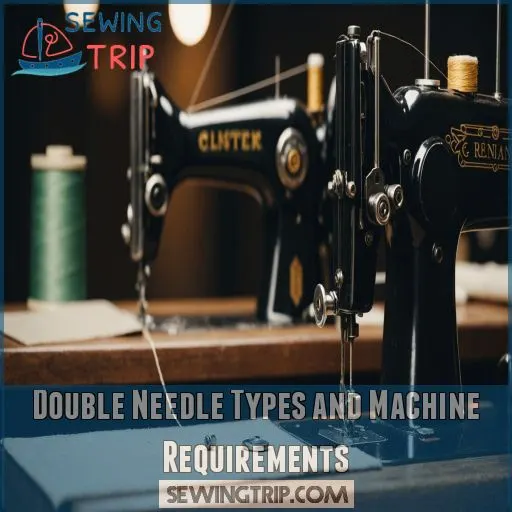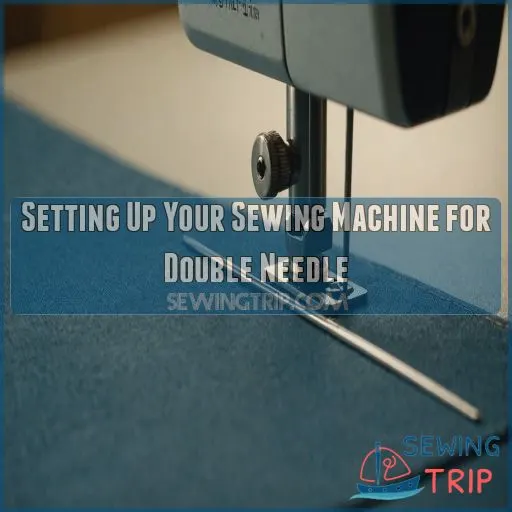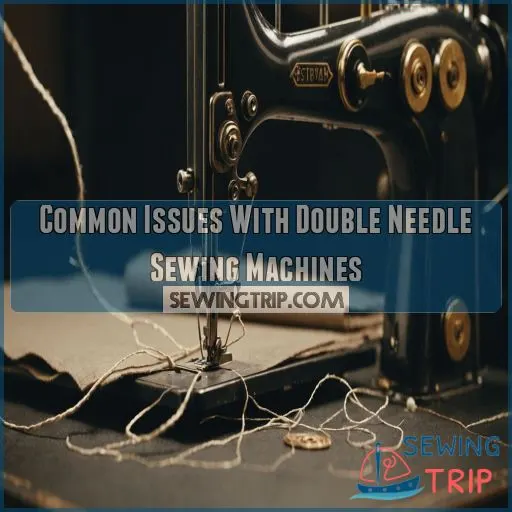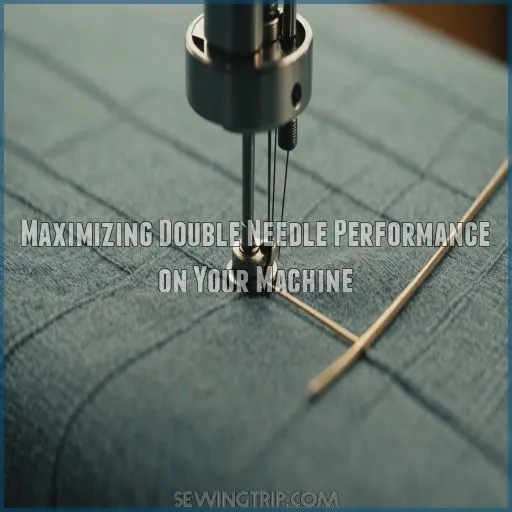This site is supported by our readers. We may earn a commission, at no cost to you, if you purchase through links.
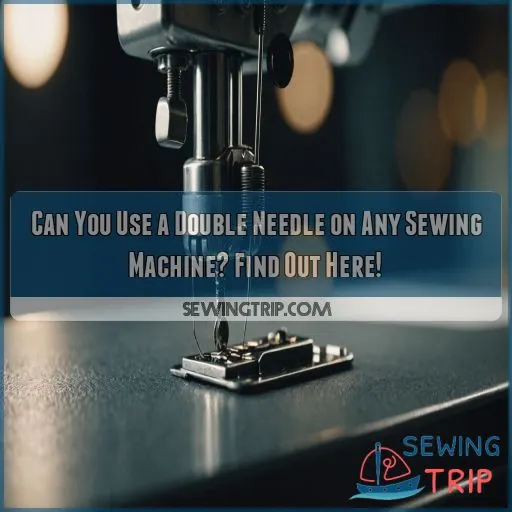
But, hang tight—older models might struggle due to throat plate width or stitch type limitations. Always check your sewing machine manual to see what’s possible. Think of it like ensuring your car can handle snow tires before winter hits.
Ready to discover your sewing machine’s potential? Stick around for more insider tips on double needle mastery!
Table Of Contents
Key Takeaways
- Not all sewing machines are double-needle friendly. If yours can zigzag, it might be game on. But do your homework—check that manual first. It’s like making sure your bike has air before hitting the trail.
- Threading two needles isn’t double the headache, promise. Just keep those threads separate, like siblings on a road trip, to avoid tangles. Get your tension right, and you’re golden.
- Double needles shine best on stretchy fabrics, giving hems that professional touch we all crave. Think of it as giving your sewing projects a red-carpet makeover.
- Tread lightly around common hiccups like tunneling and popped stitches. Adjusting tension and stitch length is like finding the sweet spot on a wobbly seesaw—but you can do it.
Can Any Sewing Machine Use Double Needle
If you’ve ever wondered whether you can use a double needle on your sewing machine, you’re not alone—it’s a common question with a surprisingly simple answer.
While many machines are compatible, it’s always a good idea to check your manual first, because nobody wants to spend hours untangling thread spaghetti.
What Machines Are Compatible With Double Needles
When considering double needle compatibility, most modern sewing machines can handle them—just don’t assume yours is one.
Older machines may have limitations.
Double needles work best if your machine supports zigzag stitching and has a wide throat plate.
Importance of Checking Your Machine’s Manual
Before you start double needle sewing, check your sewing machine’s manual. This little book is the key to making sure you succeed.
Follow these steps:
- Make sure your machine is compatible with double needles.
- Note any machine limitations.
- Find ideal needle size.
- Adjust thread tension.
Factors Affecting Double Needle Compatibility
Your sewing machine’s needle bar, throat plate, and presser foot all play a role in double needle compatibility, so it’s good to check your sewing machine accessories to see if your machine can handle it.
Check your manual to make sure your machine can handle the extra needle and thread without issues like skipped stitches or thread breakage.
Double Needle Types and Machine Requirements
When you’re looking for the right double needle, you’ve got a variety of types made for all kinds of sewing adventures, from universal to specialized options for knits and denim.
Just make sure your machine can handle these handy tools, or you might end up in a tangled mess more frustrating than a cat in a yarn store!
Universal Twin Needles and Their Uses
Now you know which sewing machines play nice with a double needle. Let’s talk universal twin needles. They’re great for:
- Universal twin needle benefits
- Heirloom sewing
- Fun stitching techniques
A pinch of versatility!
Ball-Point and Stretch Twin Needles for Knits
You’ve tackled universal twin needles; now let’s talk about knitting those stretchy wonders.
Ball-point and stretch twin needles are your secret weapons for tackling knits, preserving fabric integrity, and avoiding poppin’ stitches on hems!
Denim and Embroidery Twin Needles
Denim and embroidery twin needles offer specialized stitching for tough fabrics and decorative projects. Choose the right needle and thread type to elevate your sewing with a professional touch.
Twin Needle Size and Gap Variations
Choosing the right twin needle size and gap is really important for your sewing machine.
Smaller gaps suit knits, while wider ones handle denim or a pant leg hem.
Experiment like a chef seasoning to taste!
Setting Up Your Sewing Machine for Double Needle
Setting up your sewing machine for a double needle isn’t rocket science—just a bit of crafty magic.
With the right tweaks, you’ll have those parallel stitches looking as professional as a runway miracle.
Installing the Double Needle on Your Machine
First things first, make sure your sewing machine is compatible with a double needle. Check the shank height to see if it’s compatible.
Insert the double needle like a boss, keeping it snug and steady.
This magic setup supports foolproof stitching.
Threading the Twin Needle Correctly
Threading your twin needle is a breeze – just treat each thread separately, passing them through the needle eyes one by one. No tangles here, just smooth sailing!
Adjusting Thread Tension for Smooth Sewing
Getting your thread tension just right feels like hitting the jackpot!
Consider these steps to smooth things out:
- Evaluate your needle size.
- Inspect fabric type.
- Check stitch length.
- Test tension frequently.
Using a Walking Foot for Even Fabric Feed
Fancy a smoother sail? The walking foot’s there to keep fabric feeding even.
It’s an unsung hero in your sewing toolkit, ensuring your double needle doesn’t create havoc.
No more fabric bunch-ups!
Common Issues With Double Needle Sewing Machines
When sewing with a double needle, you might run into issues like tunneling or popped stitches, making you feel like your fabric has taken up mountain climbing.
Don’t worry; with a bit of patience and tweaking, you can fix inconsistent stitching and overcome machine quirks to get those perfect seams.
Troubleshooting Tunneling and Popped Stitches
Encountering tunneling or popped stitches? Adjust your needle tension and stitch length.
A walking foot can help, and using a stabilizer may prevent fabric distortion.
Don’t fret – with a little trial and error, you’ll master double needle sewing in no time!
Solutions for Inconsistent Stitching and Thread Breakage
Frustrated with inconsistent stitching and thread breakage? Adjust your sewing machine tension, it’s as delicate as balancing a tightrope.
Use the right needle size for the fabric type.
And don’t forget: a walking foot keeps the double needle dance smooth.
Overcoming Machine Limitations and Restrictions
Wrestling with machine limitations can be a real needle-in-the-haystack!
Try alternative sewing methods, like using compatible attachments or clever DIY solutions.
Perhaps your machine needs a little modification to fit that double needle.
Tap into its full potential and stitch on!
Maximizing Double Needle Performance on Your Machine
To get the best results with your double needle, make sure to choose the right stitch length and type for your project.
Experiment with decorative stitches and variations.
Before you know it, you’ll be sewing hems so smooth and professional, even your sewing machine might applaud!
Choosing the Right Stitch Length and Type
When sewing with a double needle, choosing the right stitch length and type can make all the difference.
Opt for a slightly shorter stitch, around 3-3.5, to prevent tunneling on knit fabrics.
Experiment with straight, stretch, or zig-zag stitches to find your perfect match.
Tips for Smooth and Professional-Looking Hems
Ready for smooth, professional-looking hems? Choose the right fabric, needle size, and stitch length for your sewing machine to ensure even, spaced stitches. Adjust thread tension to perfection. Use these tips to conquer double needle challenges, creating hems that look like you’ve bought them straight from "Sewing with Nancy"!
| Tip | Description |
|---|---|
| Fabric Choice | Select stretch fabrics for best results. |
| Needle Size | Match needle size to fabric thickness. |
| Thread Tension | Adjust for smooth seams with no loops. |
| Stitch Length | Opt for 3-3.5 effective hemming length. |
Exploring Decorative Stitches and Twin Needle Variations
Diving into decorative stitch ideas, try experimenting with twin needle spacing for exciting embroidery variations.
Don’t forget Nancy Zieman’s tip: use a free-standing spool holder!
Pintuck techniques offer elegance, while coverstitch alternatives give freedom on projects like a faux-wrap pencil skirt.
Frequently Asked Questions (FAQs)
How do you use a twin needle on a regular sewing machine?
Think of a twin needle as your sewing machine’s training wheels for a perfect hem, especially when working with heavy duty thread like Spagetti!
You’ll need a zigzag-capable machine, install the needle, thread two spools, and test on scrap fabric.
Adjust tension to avoid tunneling.
Do you need two spools of thread for a double needle?
You’ll need two spools of thread—like a two-for-one stitching jackpot!
One goes into the right needle, the other into the left.
It’s like threading a teamwork necklace for your sewing machine’s dynamic duo, but check out these troubleshooting tips for any hiccups along the way.
What stitch to use with a double needle?
Picture stitching a perfect road: smooth, parallel, unwavering.
Use a straight stitch with a double needle for a clean, parallel finish.
This technique helps your sewing machine mimic the professional look of ready-to-wear garments.
Why use a twin needle sewing machine?
Using a twin needle sewing machine lets you create professional-looking hems and seams on stretchy fabrics, just like checking out the right needle for your project.
The parallel stitches add flexibility and prevent popped threads, giving your projects a polished, store-bought finish.
Can I use a double needle for decorative stitching?
Harness the power of double needles to add pizzazz to your projects with decorative stitching.
Explore different threads and patterns, weaving creativity and flair into your designs like a maestro conductor leading an orchestra into harmony.
How do I adjust the tension for double needle sewing?
To adjust tension for double needle sewing, experiment with the tension dial until stitches look balanced.
Too loose? Threads might loop.
Too tight? Fabric could pucker.
Don’t stress; it’s like finding the sweet spot on a seesaw!
What are the benefits of using a double needle?
Did you know using a double needle can increase seam flexibility by up to 50%?
It’s like giving your sewing projects a stretch makeover, perfect for knits, preventing popped threads, and adding a polished, store-bought finish.
Can I use different thread types with a double needle?
Just grab two spools of thread and get ready to create some eye-catching stitches.
The key is adjusting your machine’s tension to keep those parallel lines looking sharp.
Have fun experimenting with different thread combos!
How do I properly store a double needle when not in use?
Treat your double needle like a delicate treasure—store it in a small, labeled case or an old mint tin to keep it safe.
This prevents bending and keeps it ready for action when creativity strikes!
Conclusion
If you’re thinking about using a double needle, knowledge is truly power.
Can you use a double needle on any sewing machine? Well, not always, but with the right set-up, many can!
Double-check your machine’s manual to dodge any snags. It’s like choosing the perfect pair of shoes: the right fit makes all the difference.
When you truly understand your machine’s quirks and potential, double needle mastery is within reach, transforming your projects into remarkable works of art.

